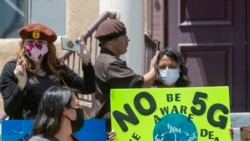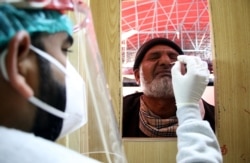In an official statement on May 20, the synod of the Orthodox Church of Moldova urged the government to make any eventual vaccine against the deadly coronavirus voluntary.
"Societies in many European countries are protesting against the mandatory use of vaccines, particularly vaccines against COVID-19, because they view them as an opportunity for the global system of anti-Christs to introduce microchips into the human body and control people with the help of 5G technology," the statement said.
It was a bizarre cocktail of fashionable conspiracy theories, many of which have coalesced around the development of the next generation of wireless data services known as "5G." And the church in Moldova is not alone in such thinking.
On May 2, the head of Russia's North Ossetia region, Vyacheslav Bitarov, told journalists that vandals had destroyed a cell-phone tower in the village of Nogir out of fears of some connection between 5G technology and the coronavirus.
"A lot of people are saying there is no coronavirus and there is no danger, but that it is all organized by some global forces that are interested in forcing people...onto reservations and then irradiate them from 5G antennae so that they would lose consciousness and then be implanted with microchips," Bitarov was quoted by TASS as saying. "There are a lot of people who think like that."
Such unfounded allegations play upon and bolster widespread public skepticism of governments in matters of health and safety. And they are particularly insidious during the current global health crisis, as they threaten to drown out necessary, science-based information about the deadly COVID-19 pandemic and how to effectively combat the spread of the coronavirus.
Any link between 5G technology and COVID-19 is "complete rubbish," Simon Clarke, an associate professor of cellular microbiology at the University of Reading told the BBC. Stephen Powis, England medical director of the U.K.'s National Health Service, has said the claims of a link are "the worst kind of fake news."
The Origin Story
Fifth-generation (5G) cellular-network technology began being deployed globally in 2019. It promises greater bandwidth and much faster data transmission, up to 10 gigabits a second -- or about 100 times faster than current 4G technology.
This is achieved, however, by using a higher radio frequency than 4G networks. Some of the frequencies used only travel about 1.6 kilometers and have trouble penetrating certain construction materials. As a result, a 5G network requires a much denser deployment of antennae. As of April 2019, operators in 88 countries had begun deploying 5G technology.
Almost immediately, however, anti-5G groups began forming on social media. People posted fake photographs of radiation-warning signs supposedly attached to 5G antennae, for instance. Unsubstantiated and debunked claims ran wild that the technology caused cancer or mental illness, that it killed trees and wildlife, and so on.
The anti-5G movement found eager allies in the larger movement of people who oppose all types of mandatory vaccinations -- anti-vaxxers -- and in many countries, such as Romania, the movements virtually merged.
Small protests were seen around the world.
A May 2019 feature in The New York Times noted that RT America, the Russian state-funded broadcast network in the United States, had published one anti-5G story in 2018, but seven in the first four months of 2019, including one claiming that children were particularly susceptible to cancer and other illnesses purportedly caused by radiation from 5G systems.
"Hundreds of blogs and websites appear to be picking up [RT's] 5G alarms, seldom if ever noting the Russian origins," the Times piece argued. "Analysts call it a treacherous fog."
The International Commission on Non-Ionizing Radiation Protection (ICNIRP) has conducted a long-running study that has concluded there are no health hazards associated with the types of radio-wave radiation used by 5G.
Along Came Coronavirus
When the global COVID-19 pandemic emerged in early 2020, numerous unfounded conspiracy theories attempted to link the virus with 5G technology. Some argued that 5G radiation weakened the immune system and left people vulnerable to the illness. Others went further and claimed the virus was actually transmitted by 5G signals. Some, like the Orthodox Church in Moldova, argued that 5G technology and an eventual coronavirus vaccine were part of a massive mind-control plot.
A number of celebrities, including actor Woody Harrelson, boxer Amir Khan, television celebrity Amanda Holden, and others posted the dubious claims on their social-media accounts. Some have claimed erroneously that a new design of Britain’s 20-pound note contains secret symbols of a 5G tower and the coronavirus.
Such misinformation, which has been dubbed "the coronavirus infodemic," spread like wildfire, according to the Swedish data firm Earhart Business Protection Agency. Earhart tracked 35 of the most popular 5G-coronavirus videos that appeared on social media in January and found that within weeks they had been viewed nearly 13 million times. The popular video-sharing application TikTok has emerged as "a very powerful tool" targeting younger audiences, the study found.
The unfounded rumors sparked a global wave of vandalism against 5G antennae and objects believed to be connected to 5G networks. More than 70 5G masts have been damaged or destroyed in the United Kingdom. In the United States, the Department of Homeland Security issued a warning that such conspiracy theories linking 5G and COVID-19 "are inciting attacks against the communications infrastructure."
RFE/RL's Coronavirus Crisis Archive
Features and analysis, videos, and infographics explore how the COVID-19 pandemic is affecting the countries in our region.
"Violent extremists have drawn from misinformation campaigns online that claim wireless infrastructure is deleterious to human health and helps spread COVID-19, resulting in a global effort by like-minded individuals to share operational guidance and justification for conducting attacks against 5G infrastructure, some of which have already prompted arson and physical attacks against cell towers in several U.S. states," the warning said.
StratCom, the European Council’s task force on disinformation within the European Union and its neighborhood, concluded in a report in April that such conspiracy theories have found "fertile soil in the Western Balkans, where disinformation that the 5G network is causing the [COVID-19] pandemic has spread on social networks and portals."
Chernobyl Syndrome
The World Health Organization (WHO) and others have responded to the 5G misinformation by actively countering it. The WHO has created a page on its website devoted to debunking 5G conspiracies, as have other fact-checking organizations. The British fact checker Full Fact, for instance, regularly examines bogus 5G claims.
However, such baseless conspiracy theories often gain traction because of growing public mistrust of governments in the areas of health and safety. Such mistrust has been exploited and cultivated by the anti-vaccination movements.
In a recent interview with RFE/RL, Nobel Prize-winning Belarusian author Svetlana Alexievich seemed to endorse the 5G conspiracy theories.
The pandemic "is the biggest challenge since Chernobyl," she said, referring to the 1986 accident and meltdown at the Chernobyl nuclear power plant in Ukraine, then part of the Soviet Union. "It remains to be seen whether this is really the flu or whether 5G affects the human immune system. In my opinion, scientists have no definitive conviction."
Although no reputable scientific study has confirmed any of the conspiracy claims about 5G and coronavirus, Alexievich's comparison to Chernobyl is noteworthy.
That incident has become notorious as an example of government indifference to public health, as the Soviet government hid the scope of the disaster for weeks and exposed its own citizens to grievous immediate and long-term health hazards. It is an example often cited by 5G conspiracy theorists -- along with others such as the thalidomide scandal of the 1950s and 1960s, and the Tuskegee syphilis experiment -- when arguing that governments are not to be trusted.
The Full Fact fact-checking website has argued that "simply asking Internet companies to delete this content is not an adequate response in a free society, is unlikely to work, and could even make things worse."
"People are understandably scared, stressed, and confused, and we need to take that into account in any response," the website concluded. "Not everybody will be convinced. Some people just like conspiracy theories, and they may not be persuaded by the facts. But as the fears around 5G have entered the mainstream, it's on all of us to counter these arguments head-on with clear, high-quality information to convince those who have questions and concerns, rather than simply dismiss them as foolish."
COVID-19 is a serious, infectious disease caused by a newly discovered coronavirus that emerged in Wuhan, China, in late 2019. The virus is transmitted primarily through droplets of saliva or nasal discharge dispersed when an infected person coughs or sneezes. According to the Johns Hopkins University Coronavirus Resource Center, there have been more the 6 million confirmed coronavirus infections globally as of May 31 and more than 365,000 fatalities.





















